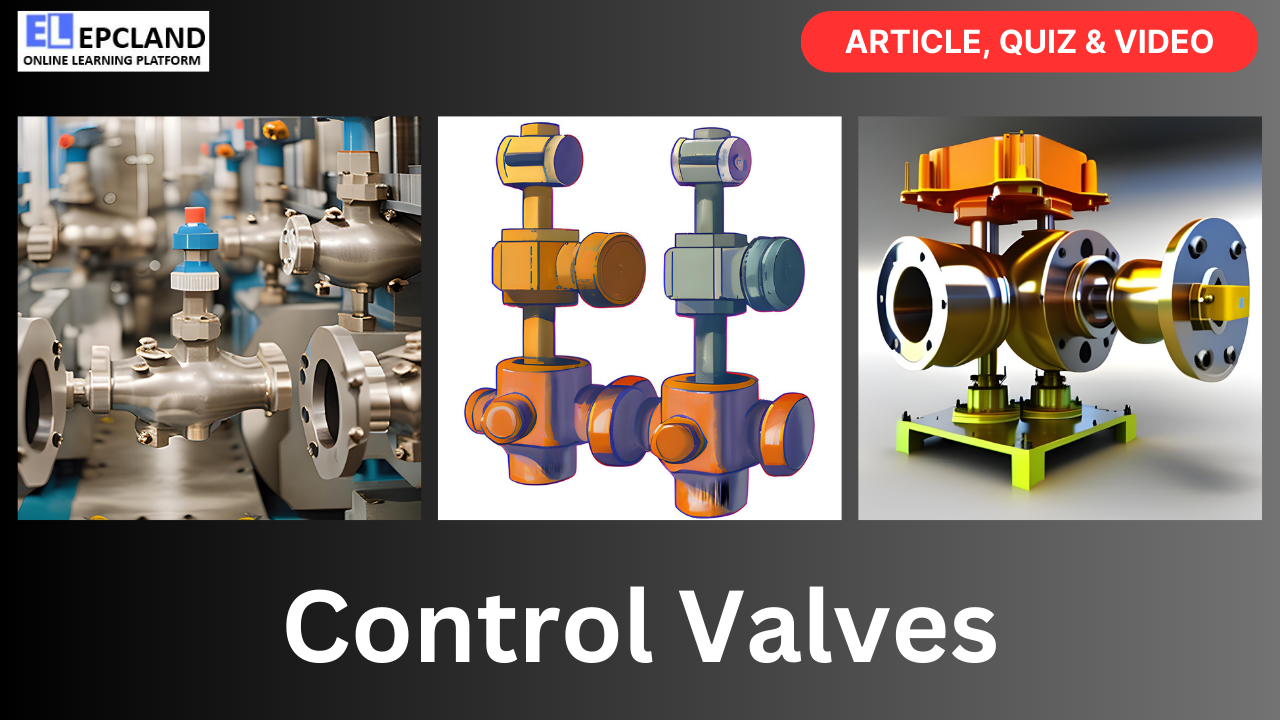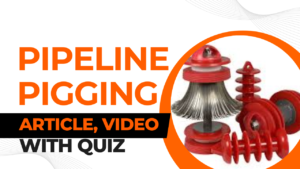Control valves are the unsung heroes of the Oil & Gas industry. These critical components may appear deceptively simple, but they play a pivotal role in regulating fluid flow, ensuring safety, and optimizing processes in the complex world of Oil & Gas projects. This article provides an in-depth exploration of control valves, their types, functions, applications, working principle, and the crucial role they play in the success of oil and gas ventures.
Table of Contents
Do not miss the Complete Course on Piping Engineering
By EPCLand
Introduction to Control Valves
Control valves are mechanical devices designed to regulate the flow of fluids within a pipeline or process system. They precisely control the flow rate, pressure, temperature, or level of liquids, gases, or steam. In the context of Oil & Gas projects, control valves are indispensable for maintaining safe and efficient operations.
The Significance of Control Valves
Control valves hold immense significance in the Oil & Gas industry for several reasons:
- Flow Control: They ensure that the right amount of fluid is delivered at the right time, critical for various processes from drilling to refining.
- Safety: Control valves are key components in safety systems, responsible for shutting down processes in case of emergencies or abnormal conditions.
- Efficiency: They help optimize processes, maximize production, and minimize energy consumption.
- Environmental Compliance: Control valves contribute to minimizing emissions and maintaining compliance with environmental regulations.
- Quality Control: Precise control of fluid parameters ensures product quality and consistency.
Types of Control Valves
Control valves come in various types, each designed for specific applications and control purposes. The choice of valve type depends on factors such as fluid properties, operating conditions, and the desired control performance. The primary types of control valves used in Oil & Gas projects include:
1. Globe Valves
Function: Globe valves are versatile and commonly used for precise throttling or modulating control. They offer good shut-off capabilities.
Applications: These valves are used in various processes, including steam control, level control, and high-pressure applications like boiler feedwater control.
2. Ball Valves
Function: Ball valves provide quick on-off control and are less suitable for throttling applications. They offer tight shut-off capabilities.
Applications: Ball valves are often used in isolation applications, such as shutting off the flow in emergency situations or for low-pressure control applications.
3. Butterfly Valves
Function: Butterfly valves are suitable for quick and efficient flow control. They provide a balance between shut-off capabilities and control performance.
Applications: Commonly used in large-diameter pipelines, such as those for transporting crude oil, and in applications where rapid isolation is necessary.
4. Plug Valves
Function: Plug valves have a cylindrical or tapered plug that can be rotated to control flow. They are suitable for both on-off and moderate throttling control.
Applications: Used in applications with high-pressure differentials, abrasive fluids, or where bubble-tight shut-off is required.
5. Diaphragm Valves
Function: Diaphragm valves use a flexible diaphragm to control flow. They are suitable for applications requiring a high degree of cleanliness and where contamination is a concern.
Applications: Often used in applications involving corrosive or abrasive fluids and in the pharmaceutical and food industries.
Control Valve Components
A typical control valve consists of several essential components that work together to control fluid flow accurately. Understanding these components is crucial to appreciate the complexity and precision of control valve design and operation:
1. Valve Body
The valve body serves as the primary structural component, housing other internal components. It determines the flow path and is designed to withstand the fluid pressure and temperature.
2. Actuator
The actuator is responsible for positioning the valve closure member (e.g., the plug, ball, or disk) to control flow. Actuators can be pneumatic, hydraulic, or electric and play a vital role in the responsiveness and accuracy of the valve.
3. Valve Closure Member
The closure member is the part of the valve that controls the flow of fluid. It can be a plug, ball, disk, or diaphragm, depending on the valve type. The design of the closure member determines the valve’s control characteristics.
4. Valve Seat
The valve seat is the surface against which the closure member seals to stop or control flow. Proper seating is essential for achieving tight shut-off.
5. Bonnet
The bonnet covers and protects the internal components of the valve, such as the actuator and stem. It also provides access for maintenance and repairs.
6. Stem
The stem connects the actuator to the closure member and transmits the actuator’s motion to control the flow. It must be durable and capable of withstanding the forces exerted during operation.
Do not miss the Complete Course on Piping Engineering
By EPCLand
Control Valve Working Principle
The working principle of a control valve is based on the regulation of flow by changing the effective flow area through which the fluid passes. Here’s a simplified explanation of how control valves work:
- Flow Control: The control valve’s closure member, which can be a plug, ball, disk, or diaphragm, is positioned within the flow path.
- Actuation: The actuator, driven by a control signal, moves the closure member to adjust its position within the flow path.
- Flow Area: As the closure member moves, it changes the effective flow area available for the fluid to pass through.
- Flow Rate Adjustment: By altering the flow area, the control valve regulates the flow rate of the fluid. When the closure member is fully open, maximum flow is allowed, while closing it reduces the flow rate.
- Control Signal: The control signal, often generated by a process controller, is used to precisely position the closure member to maintain the desired flow rate, pressure, temperature, or level.
The control valve continuously modulates its position in response to the control signal to maintain the desired process conditions, ensuring precise control over the fluid.
Control Valve Functionality
The primary function of control valves is to regulate fluid flow, but they achieve this in different ways, depending on the control requirements. The two fundamental control valve functions are:
1. On-Off Control
On-off control valves are primarily used for isolating or diverting the flow of fluids. They are not suitable for precise flow control but excel in providing tight shut-off capabilities. Ball valves and gate valves are common examples of on-off control valves used in the Oil & Gas industry.
2. Modulating Control
Modulating control valves are designed to control flow continuously within a range. They are suitable for applications where precise control of flow rate, pressure, or temperature is required. Globe valves, butterfly valves, and diaphragm valves are commonly used for modulating control in Oil & Gas processes.
Control Valve Accessories
Control valves can be enhanced with various accessories and instrumentation to improve their performance and functionality. Some common accessories include:
1. Positioners
Positioners work in tandem with the actuator to precisely position the closure member. They receive signals from a controller and adjust the valve’s position to maintain the desired setpoint.
2. I/P Converters
I/P (current-to-pressure) converters are used to convert electrical signals from a controller into pneumatic signals that actuate the control valve.
3. Position Transmitters
Position transmitters provide feedback on the valve’s actual position, allowing for closed-loop control and continuous monitoring.
4. Limit Switches
Limit switches are used to provide electrical feedback to indicate when a valve has reached a fully open or fully closed position. They are essential for safety and process control.
5. Solenoid Valves
Solenoid valves are used to control the air supply to pneumatic actuators, enabling quick opening or closing of the valve.
Applications of Control Valves in Oil & Gas Projects
Control valves are employed throughout the Oil & Gas industry, from upstream exploration and production to downstream refining and distribution. Their applications are diverse and crucial for ensuring efficient and safe operations.
1. Wellhead Control
In upstream operations, control valves are used at wellheads to regulate the flow of oil and gas from reservoirs. These valves control pressure, flow rates, and the separation of oil, gas, and water.
2. Pipeline Control
Control valves are integral to the transportation of oil and gas through pipelines. They regulate flow rates and pressures to ensure the safe and efficient movement of hydrocarbons over long distances.
3. Refining Processes
In refineries, control valves play a critical role in processes such as distillation, catalytic cracking, and hydrotreating. They help optimize temperature and pressure conditions to refine crude oil into valuable products.
4. Process Heating and Cooling
Control valves are used in heat exchangers and cooling systems to control the flow of heating or cooling media. This ensures precise temperature control in various processes.
5. Emissions Control
In compliance with environmental regulations, control valves are employed in emissions control systems to regulate the flow of gases and minimize air pollutants.
6. Safety Systems
Control valves are an integral part of safety systems in the Oil & Gas industry. They play a crucial role in emergency shutdown (ESD) systems, ensuring rapid isolation of equipment and processes in hazardous situations.
Do not miss the Complete Course on Piping Engineering
By EPCLand
Control Valve Sizing and Selection
Selecting the right control valve for a specific application is a complex task that involves considering various factors, including:
1. Flow Characteristics
Different control valve designs have varying flow characteristics, such as linear or equal percentage. The choice depends on the process requirements.
2. Flow Capacity
The valve must be sized to handle the required flow rates while maintaining the desired control performance. Oversized or undersized valves can lead to inefficiencies.
3. Pressure Drop
The control valve’s design and size should minimize pressure drop across the valve to maintain process efficiency.
4. Fluid Properties
The properties of the fluid being controlled, including temperature, viscosity, and corrosiveness, must be considered when selecting materials and design.
5. Control Performance
The valve should be chosen based on the required control performance, including accuracy, response time, and stability.
6. Safety Requirements
For safety-critical applications, control valves must meet stringent safety and reliability standards.
Maintenance and Troubleshooting
To ensure the continued reliable performance of control valves in Oil & Gas projects, regular maintenance and troubleshooting are essential:
1. Routine Inspection
Control valves should undergo routine inspection to check for wear and tear, leakage, and proper operation. Lubrication and cleaning may be required.
2. Calibration
Calibration ensures that the valve is operating in accordance with the control signal. Periodic calibration checks are necessary to maintain accuracy.
3. Diagnostics
Advanced diagnostics, including valve position monitoring and predictive maintenance, can help identify issues before they lead to costly failures.
4. Troubleshooting
In the event of a malfunction or abnormal operation, troubleshooting procedures should be followed to identify and rectify the problem promptly.
Challenges in Control Valve Applications
Despite their critical role, control valves face several challenges in Oil & Gas applications:
1. Harsh Operating Conditions
Oil & Gas processes often involve extreme temperatures, pressures, and corrosive substances, which can lead to valve wear and deterioration.
2. Erosion and Cavitation
High-velocity flows can cause erosion and cavitation, which can damage valve components and degrade performance.
3. Safety and Environmental Concerns
Ensuring the safety of control valve operation and minimizing environmental impact are paramount in the Oil & Gas industry.
4. Maintenance and Reliability
Accessing and maintaining control valves in remote or hazardous locations can be challenging, necessitating advanced maintenance strategies.
Table of Advantages and Disadvantages of Control Valves
Here’s a table summarizing the advantages and disadvantages of control valves in Oil & Gas projects:
| Advantages | Disadvantages |
|---|---|
| Precise flow control | Complex selection and sizing process |
| Enhanced safety | Potential for wear and erosion |
| Efficient process optimization | Maintenance and calibration needs |
| Compliance with environmental standards | Potential for cavitation and noise |
| Reliable shut-off capabilities | Costly for large-diameter pipelines |
| Versatility for various applications | Challenges in extreme conditions |
Future Trends in Control Valves for Oil & Gas
The Oil & Gas industry is continually evolving, and control valves are no exception. Several trends are shaping the future of control valves in the industry:
1. Smart Valves
Smart control valves equipped with sensors and communication capabilities are becoming more prevalent. These valves provide real-time data on performance, enabling predictive maintenance and process optimization.
2. Advanced Materials
The development of advanced materials with enhanced resistance to corrosion and erosion will extend the lifespan of control valves in harsh environments.
3. Digital Twins
Digital twin technology allows for the creation of virtual models of control valves and their associated systems, enabling better monitoring, analysis, and optimization.
4. Green Technologies
Environmental sustainability is a growing concern in the industry. Control valves will play a role in optimizing processes for reduced emissions and energy consumption.
Conclusion
Control valves are the unsung heroes that ensure the smooth operation, safety, and efficiency of Oil & Gas projects. They come in various types, each suited to specific applications, and are equipped with accessories and instrumentation to enhance their functionality. From wellhead control to emissions management, control valves are omnipresent in the industry.
Selecting, maintaining, and troubleshooting control valves are critical tasks that demand careful consideration and expertise. As the Oil & Gas industry continues to evolve, control valves will adapt to meet the challenges of harsh environments, safety requirements, and environmental concerns.
In the future, smart valves, advanced materials, digital twins, and sustainable technologies will play a pivotal role in shaping the next generation of control valves, ensuring that they remain essential components in the Oil & Gas industry’s quest for efficiency, safety, and sustainability.
FAQs
1. What is the primary function of control valves in Oil & Gas projects?
Control valves in Oil & Gas projects primarily function to regulate the flow rate, pressure, temperature, or level of fluids. They ensure that the right amount of fluid is delivered at the right time, contributing to the efficiency, safety, and quality of various processes.
2. How do control valves work, and what is their working principle?
Control valves work by changing the effective flow area through which fluid passes. The closure member within the valve, controlled by an actuator, modulates its position to adjust the flow. By altering the flow area, control valves regulate the fluid’s flow rate, pressure, or temperature, maintaining the desired process conditions.
3. What are the different types of control valves used in the Oil & Gas industry, and how are they chosen for specific applications?
Control valves come in various types, including globe valves, ball valves, butterfly valves, plug valves, and diaphragm valves. The choice of valve type depends on factors like flow characteristics, flow capacity, pressure drop, fluid properties, control performance requirements, and safety standards specific to the application.
4. What are the common challenges faced in control valve applications in the Oil & Gas industry?
Control valves in Oil & Gas projects often encounter challenges such as harsh operating conditions (extreme temperatures, pressures, corrosive substances), erosion, cavitation, safety and environmental concerns, and the need for maintenance in remote or hazardous locations. These challenges require careful selection, maintenance, and monitoring of control valves.
5. What are the future trends in control valves for the Oil & Gas industry?
The future of control valves in the Oil & Gas industry includes the adoption of smart valves with sensors and communication capabilities, the development of advanced materials for extended durability, the use of digital twin technology for better monitoring and optimization, and the implementation of green technologies to reduce emissions and energy consumption, aligning with environmental sustainability goals.
Do not miss the Complete Course on Piping Engineering
By EPCLand
Recommended courses (Published on EPCLand)
- Basics of Piping Engineering
- Piping Layout Engineering
- Piping Material Engineering
- Piping Stress Analysis
- Complete Course on Piping Engineering
- Material Requisitions
- Piping Material Specifications
- Valve Material Specifications
Don’t miss the published articles on following:
Related Video
Attempt Quiz
Question 1:
What is the primary function of a control valve in an oil & gas project?
Explanation: The primary function of a control valve in an oil & gas project is to control the flow rate of fluids, such as crude oil or natural gas.
Question 2:
Which type of control valve is commonly used for throttling applications in the oil & gas industry?
Explanation: Globe valves are commonly used for throttling or control applications in the oil & gas industry due to their precise flow control capabilities.
Question 3:
What is the purpose of a control valve actuator?
Explanation: The purpose of a control valve actuator is to control the valve’s position, allowing it to open, close, or throttle as needed to maintain the desired fluid flow rate.



